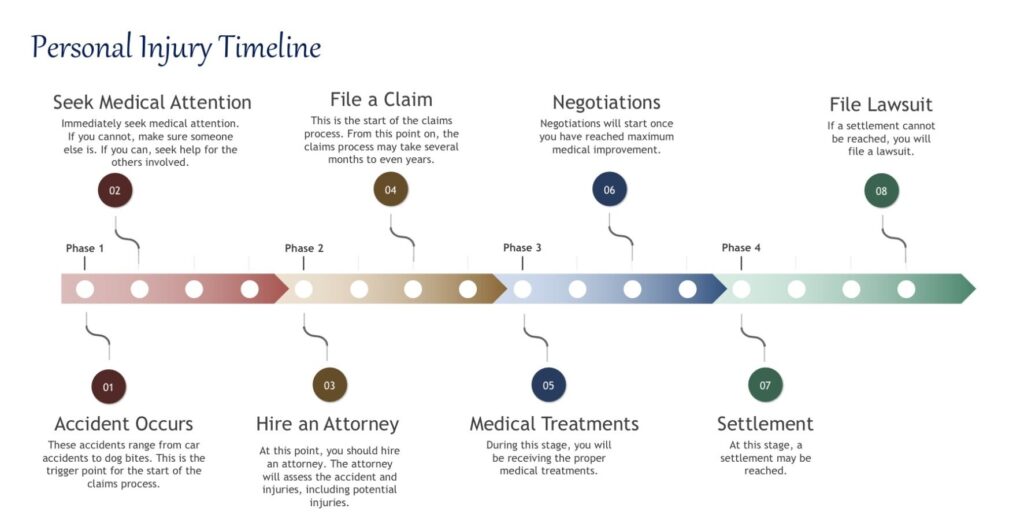Suffering an injury due to someone else’s negligence can be a stressful experience. Whether it’s a car accident, slip and fall, or workplace injury, seeking compensation for damages is crucial. The personal injury lawsuit process can seem complex, but understanding the steps involved can help you navigate it effectively. This guide will walk you through every stage of a personal injury claim, ensuring you’re well-prepared for what lies ahead.
Step 1: Seeking Medical Treatment
The first and most important step in any personal injury lawsuit process is getting medical attention. Even if your injuries seem minor, a medical evaluation is necessary for two reasons:
- Ensuring your health and well-being.
- Creating medical records that serve as crucial evidence in your claim.
Failing to seek prompt medical care can weaken your case, as the opposing party may argue that your injuries were not serious or were unrelated to the accident.
Step 2: Consulting a Personal Injury Lawyer
Once you have received medical treatment, the next step is to consult with a personal injury attorney. An experienced lawyer can:
- Evaluate the strength of your case.
- Explain your legal rights and options.
- Handle negotiations with insurance companies.
- Represent you in court if necessary.
Most personal injury lawyers offer a free consultation and work on a contingency fee basis, meaning they only get paid if you win your case.
Step 3: Investigation and Gathering Evidence
A successful personal injury lawsuit process relies on strong evidence. Your attorney will conduct an investigation to collect essential documents and proof, including:
- Medical records and bills
- Police or accident reports
- Witness statements
- Surveillance footage (if available)
- Expert testimony (medical professionals, accident reconstruction experts, etc.)
The stronger the evidence, the higher your chances of receiving fair compensation.
Step 4: Filing the Personal Injury Claim
After gathering evidence, your attorney will file a claim with the at-fault party’s insurance company. This process includes:
- Drafting a demand letter outlining your injuries, medical expenses, lost wages, and other damages.
- Submitting supporting evidence.
- Requesting a fair settlement amount.
The insurance company will review the claim and either accept, negotiate, or deny it.
Step 5: Negotiating a Settlement
Insurance companies often try to settle for the lowest amount possible. Your attorney will negotiate on your behalf to ensure you receive fair compensation. Key factors that influence settlement negotiations include:
- The severity of your injuries
- Medical expenses and future medical costs
- Lost wages and reduced earning capacity
- Pain and suffering
Many personal injury cases are settled at this stage without the need for a lawsuit. However, if the insurance company refuses to offer a fair settlement, the next step is filing a lawsuit.
Step 6: Filing a Personal Injury Lawsuit
If negotiations fail, your lawyer will formally file a personal injury lawsuit in civil court. This step initiates the litigation process, which consists of:
- Complaint Filing: A legal document outlining your claims is filed with the court.
- Defendant’s Response: The at-fault party (defendant) must respond within a specified period.
- Discovery Phase: Both parties exchange evidence, conduct depositions, and question witnesses.
The personal injury lawsuit process can take months or even years, depending on the complexity of the case.
Step 7: Mediation and Pre-Trial Settlement
Before the case goes to trial, courts often encourage mediation—a process where both parties meet with a neutral mediator to negotiate a settlement. Many personal injury cases are resolved at this stage, avoiding the lengthy trial process.
Step 8: The Trial Process
If mediation fails, the case proceeds to trial, where a judge or jury will determine the outcome. The trial process involves:
- Opening statements from both parties.
- Presentation of evidence and witness testimonies.
- Cross-examinations by attorneys.
- Closing arguments.
The judge or jury then deliberates and delivers a verdict. If you win, the court will award compensation based on your damages.
Step 9: Receiving Compensation
If you win your personal injury lawsuit, you will receive compensation, which may include:
- Medical expenses: Past, present, and future treatment costs.
- Lost wages: Compensation for income lost due to the injury.
- Pain and suffering: Compensation for emotional distress and reduced quality of life.
- Punitive damages: In cases of extreme negligence, the court may award additional compensation as punishment for the at-fault party.
If the defendant refuses to pay, your lawyer can take legal action to enforce the judgment.
Step 10: Appealing the Verdict (If Necessary)
If either party is dissatisfied with the trial outcome, they may file an appeal. An appeal is a request for a higher court to review the case and potentially overturn the decision. However, appeals can prolong the legal process significantly.
Tips for a Successful Personal Injury Lawsuit
To strengthen your case and improve your chances of winning, consider the following tips:
- Keep detailed records: Save medical bills, receipts, and any documents related to the injury.
- Avoid discussing the case on social media: Insurance companies may use your posts against you.
- Follow medical advice: Not following doctor’s recommendations may weaken your claim.
- Be patient: The personal injury lawsuit process can take time, but rushing a settlement may lead to lower compensation.
Conclusion by personal injury lawsuit process
The personal injury lawsuit process may seem overwhelming, but understanding the steps involved can help you navigate it with confidence. Seeking medical treatment, gathering evidence, hiring a skilled attorney, and negotiating effectively are key to securing fair compensation. Whether you settle or go to trial, being informed and prepared will improve your chances of success.
If you’ve been injured due to someone else’s negligence, don’t hesitate to consult a personal injury lawyer to explore your legal options.



